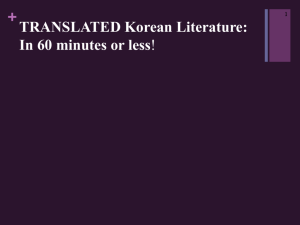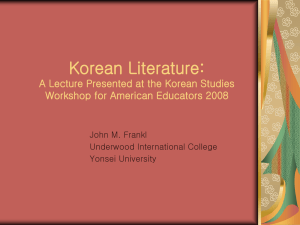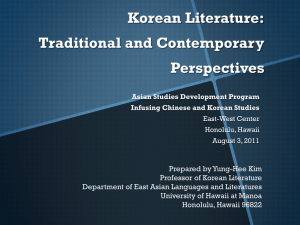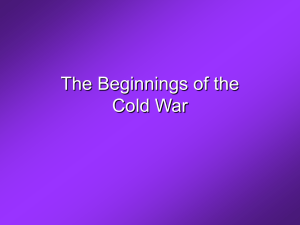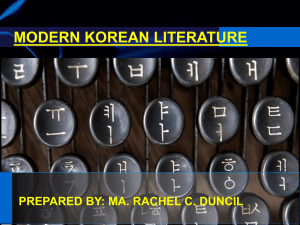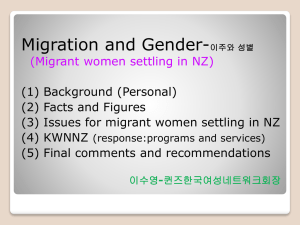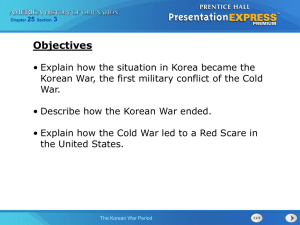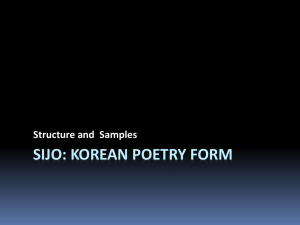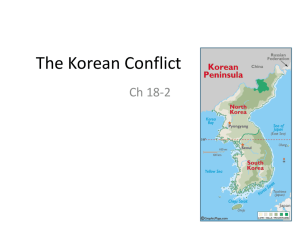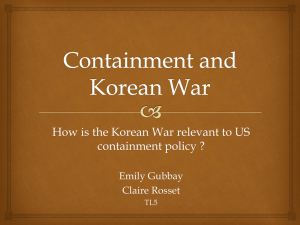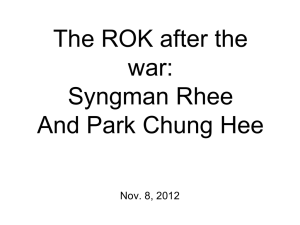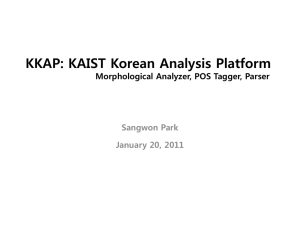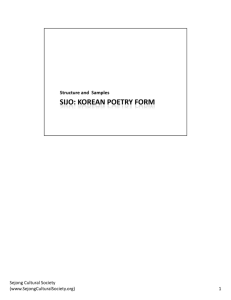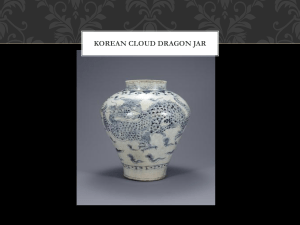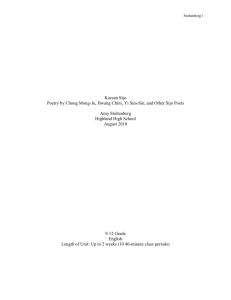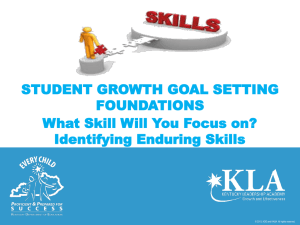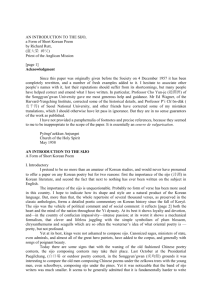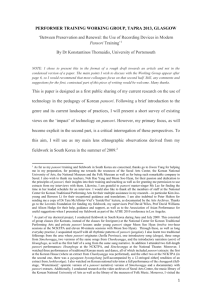KoreanLiteratureHistorySEOUL
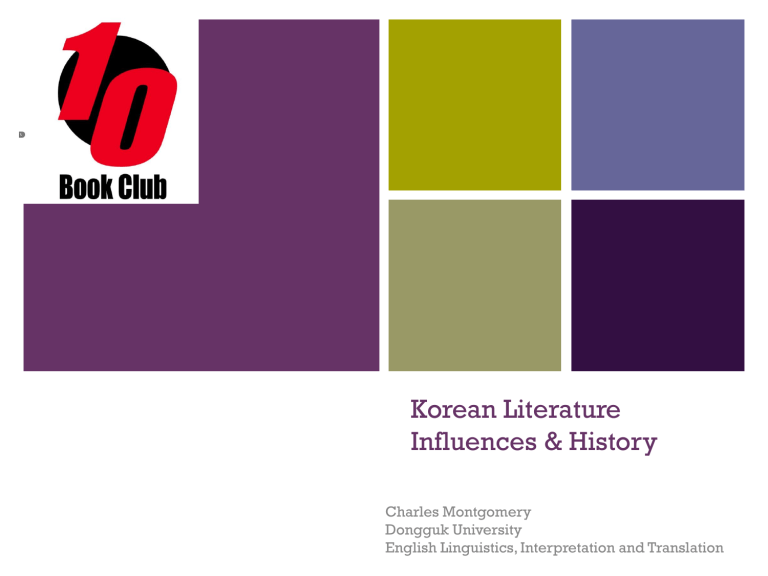
+
Korean Literature
Influences & History
Charles Montgomery
Dongguk University
English Linguistics, Interpretation and Translation
+
INFLUENCES
Shamanism
Buddhism
Confucianism
Taoism
Christianity
+
Korean Shamanism
Deep roots in folk beliefs.
Related to ancient communal worship rites offered to gods of heaven.
Seeks to resolve human problems through meeting of humans and spirits mediated by the shaman
Animism www.sejongculturalsociety.org/mediafiles/resources/korea.ppt
+
Korean Buddhism
Introduced in three kingdom era (@ 372 A.D.)
State religion in three kingdoms and Goryeo
Deep influence in every aspect of Korean life
Korea still 24% Buddhist.
www.sejongculturalsociety.org/mediafiles/resources/korea.ppt
+
Korean Confucianism
Joseon dynasty promoted Confucian philosophies as national philosophy .
Intellectual Achievement
‘Proper’ Social Structure www.sejongculturalsociety.org/mediafiles/resources/korea.ppt
+
TAOISM
Introduced to Korea from China during the Three Kingdoms
Greatest popularity during Goryeo
Remains a minor but significant element of Korean thought and integrates with animism
+
Korean Christianity
Catholicism imported into Korea by
Korean scholar, Yi Seung-hun, who was baptized while visiting China.
Protestant missionaries came during
Japanese rule in early 20 th century.
Dedicated to higher education and health care
Catholics and Protestants live in urban areas and often have higher education levels.
+
What does it add up to?
Balance between emotionalism and control
Substantial tension between beliefs across time and proximally
+
What Barriers Does this Create?
Flat Affect (High Context)
Little Agency (Socially Determined)
Gatekeeping (Current Manifestation)
Awesome Trauma Levels
Didacticism
Little interest in character motivation
Plots less important than message
+
Bad Translation
(De) Amplification
Bad themes/genres
Literality
Impossibility
+
LITERATURE – DIVIDING LINES
Classical (? – Late 19 th Century)
Modern (1900 – Now)
+
LITERATURE – DIVIDING
LANGUAGES
Hyangch’al
Chinese
Hangul
+
LITERATURE – DIVIDING
RELIGIONS
LOL… saved for another lecture.^^
+
LITERATURE – DIVIDING LINES
Men
Women
+
LITERATURE – DIVIDING LINES
Between Dynasties
+
Why include oral/song content?
Chinese vs. Korean
Little printing
Many wars
Successive dynastic destruction of written materials
Hey! Epics.
+
Korea’s Classical Poetry
Hyangga
Koryo Kasa
Sijo
Joseon Kasa
Pansori
+
Hyangga
Very little remains of the literature of the
Silla Period (57 BC to 935 AD). What does remain is the form of Hyangga poetry, which was written down in hyangch’al.
4-line, 8-line, and 10-line poems. 4-line hyangga one stanza, 8-line hyangga two 4line stanzas, and 10-line hyangga are two 4line stanzas concluding with one two-line stanzas.
+
Requiem for My Sister (Weolmyeong)
The road to life and death
Stands fearfully before us.
Without saying good-bye,
Have you left me?
The early morning wind in autumn
Scatters leaves here and there.
Though from the same branch
They know not where they've gone.
Oh my dear sister, to see you again in Amitabha's Paradise,
I shall wait, perfecting Buddha's way.
+
Koryo Kasa
Short (one stanza - dallyeonche)
Long (yeonjanche stanzas range to 13)
Stanzas have refrain in the middle/end to establish mood or link the stanzas
Less formally structured
Bolder topics
Often performed by Kisaeng
+
The Manjeoncheun
When I lie alone, restless, vigilant,
Only peach blossoms wave over the west window.
You have no grief, welcome the spring breeze.
I have believed those who vowed to each other;
"My soul will follow yours forever."
Who, who persuaded me this was true?
"O duck, beautiful duck, why do you come
To the swamp, instead of the shoal?"
"If the swamp freezes, the shoal will do."
A bed on Mount South, jade pillow, gold brocade.
And beside me a girl sweeter than musk,
Let us press our hearts together, our magic hearts.
+
Sijo
Joseon poetry shifts to sijo/kasa
Original sijo poets were yangban
3 lines of 14-16 syllables each. Total syllables between 44 and 46
Also syllabic rules for each line
Rules almost always broken, as sijo aren’t really syllabic.^ ^
+
Yi Sun-sin
Moon-bright night on Hansan Isle and I sit alone atop the lookout.
I hold my great sword by my side, and as my worries deepen, from somewhere comes the single note of the Mongol flute, piercing to the very bowels.
+
Joseon Kasa
Free verse, based on a rhythm of doubled feet with three or four syllables
Not stanzas
More narrative/descriptive
+
Kasa
There is between heaven and earth many a man who’s worth as I.
Why don’t they know the great Joy
Of living in the wooded mountains?
With a grass hut of a few bays built to face a clear blue stream,
In the lush wood of pine and bamboo
I am the master of wind and moon.
+
Pansori
Narrative poetry focused on real life
From shamanist chants of S-E Korea in late 17 th and early 18 th centuries
Long narrative musical performance with drummer and singer
A main song called ch’ang and a rhythmic spoken connective called aniri
+
Classical Prose
Tales of Kumo by Kim Shi-sup in the mid 15th century
The Tale Of Hong Gildong by Hyo
Kyun in the late 16th or early 17th century.
+
Korean Alphabet: Hangul
King Sejong the Great invented Korean alphabet in 1446.
Alphabet organizes written language into syllabic units.
14 consonants & 10 vowels
Easy to learn:
"A wise man can acquaint himself with them before the morning is over; a stupid man can learn them in the space of ten days”.
From http://library.thinkquest.org/20746/non/info/index.html
+
KOREAN CLASSICAL LIT
Oral
Therefore poetic
Chinese Characters
Full of influences we just discussed.
+
ONCE MORE: INFLUENCES^^
+
GENRES
Lyric
Narrative
Dramatic
Didactic
+
Lyric
Hyangga
Sijo and Narrative sijo
Light Songs
Lyric Folk Songs
Most classical Chinese poetry
19th Century poetry & most modern poetry
+
Narrative
Myths
Narrative Poems
Narrative Shaman Chants
Pansori
Classic and New Novels
+
Dramatic
Mask Dance
Puppet Theater
New Theater
Modern Drama
+
Didactic
Court Music (akchang)
Ch'angga
Diaries
Travelogues
+
Kim Sat-gat (Sakkat)
+
Enlightenment
Late 19 th Century
Korea’s attempt to ‘modernize’ itself
+
Summary of Classical Trends
Slow but general move towards hangul
Consequently slow but general move to expanded authorship
Slow by general move away from rarefied themes
Late development of publishing and commercial authors
+
The Death of the Yangban
Yangban was de jure conferred to those individuals who passed statesponsored civil service exams called gwageo
Slow
Deliberative
Chinese Language
+
Early Colonialism
Early Years 1905 - 1919
The shock of “failure” and Yi Kwangsu
Serialization
Post 삼일
False Summer
+
1935-1945: The “Dark” Years
Early Years
The Roaring 30s
Everyday Life in the Empire
Writings in Korean, Writing in Korean
Total Mobilization
Censorship
Writing in Japanese
+
1945-1960s: Liberation, Division, and
War
Kapitan Lee (Chon Kwangyong) and
Obaltan (Yi Beomseon)
Questions of Loyalty
A Divided Country, Divided Families
Post Traumatic Stress Syndrome
The Urge to Return (But to Where and What?)
Cranes (Hwang Sun-won)
Redefining Right and Wrong
Possibilities for Reconciliation
+
Late-Twentieth Century Literature
Miracle on the Han
Resettlement
Destruction of old social models
Rootlessness
+
Late-Twentieth Century Literature
Miracle on the Han
Seoul, 1964, Winter
A Little Ball Launched by a Dwarf
The Flower with Thirteen Fragrances
+
Yoryu Chakga: The Changing Status of
Women Writers
A Genre unto Themselves:
Women Writers and Segregation
Turn of the Century:
Women Writers as the Dominant Force in
Korean Literature
+
Coming Full Circle: Rescuing Literature
From the Nation
Nationalism in Literary Production
Writers Unbound
Kim Young-ha
Jung Young-moon
Pak Min-gyu
Kim In-sook
+
The Future
Revisiting Language and Ethnicity
Future Writers
Koreans in English
Others in Korean
Internationalization
Nation vs Inter-nation
Nobel Prize
Shin Kyung-sook
Tension with “national” literature
+
Find Me
WWW.KTLIT.COM
CHARLES@KTLIT.COM
@KTLIT
